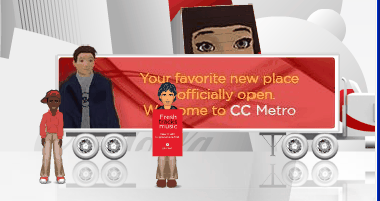They all left Second Life after internal benchmarking exercises showed things were not going so well.
Usually we say – name, content and brand matter – everything else is frosting.
However, as the experiences of famous brands with Second Life demonstrate, brand is not everything in the virtual world.
Instead, changing the act regularly, offering a thrill, avoiding control mania and asking your employees for help will increase your chances for success in the virtual worlds of today and tomorrow.
What have Famous Brands in Common?
Famous brands do many things in a competitive business environment. For starters, they portray a life style, image, recognition and sometimes even trust. The fashion folks are master at this and show us how it works each year with their new design shown on cat walks around the globe, such as:
– Milan Fashion Week – feels like doing the time warp all over
Naturally, when Web 2.0 arrived and virtual worlds popped up, brands tried to protect their territory and established a presence. Unfortunately, neither for Daimler (i.e. Mercedes-Benz), AOL nor Wells Fargo (the bank) did Second Life bring the success they wanted. They all decided to quit Second Life – the virtual world – after failing to attract the attention, traffic and more they expected.
– Mercedes-Benz ends Second Life test run with positive findings
– AOL Leaves Second Life; Looking for New Virtual World Opportunities
What Does it Take for Success in the Virtual World?
Based on our review of these cases it seems that success in virtual worlds such as Second Life requires two things:
- 1) Regular change (once a month is the minimum) seems to be the one required feature for a Second Life presence to attract regular traffic. Similar to a nightclub, the main act has to change.Hence, for Second Life or a nightclub, the main products are insufficient to maintain the level of traffic required to keep the buildings open.
The acts help to maintain high traffic levels. What virtual worlds do not have is a rotation schedule for famous people (pop or movie stars).
2) Games in Second Life are similar to an amusement park where the roller coaster is a tougher ride on different days.
This makes it part of the thrills economy. If neither a game nor thrill is being offered, the main act had better be good to maintain traffic levels.
Hence, if there is neither change at regular intervals (e.g., new act, game, etc.) or a game to play, the corporate presence in virtual worlds such as Second Life is unlikely to spell success for a famous brand.
| If this post was helpful to you, please consider stumbling this post from CyTRAP Labs | |
| Also of interest: | |
| the Mission of ComMetrics | why Benchmark |
| Trivia and Trends – Second Life and Diplomacy | 1 BlackBerry at the beach – 5 tips for getting the most out of your vacation |
Bottom Line
Neither Volkswagen nor Nissan may succeed with their islands on Second Life. Nevertheless, their product can benefit from being present in a particular domain or scenario playing on Second Life because even in the virtual world, cars are required.Hence, those brands that fit by form and function in the virtual space will benefit by gaining recognition and a ‘cool’ image.
Else, one can try to follow Coke’s strategy. It went from its own site to shift over to CC Metro. If you cannot see the image to the right, see Coke’s virtual world
Cokestudios was an online game that had a really great and unique game play going. How the new site was changed is not to many users’ likings. While Coke officials tout its success, online forums discussing the new site tell us a different story.
Coke users were not happy when Coke’s virtual world closed
So What Lessons Have we Learnt?
The lessons listed below also indicate that your virtual world must serve a need for visitors to come back. And as well, unless your potential and current customers make use of your virtual world or services, why have them?
Here come our 4 lessons that we should consider before creating a virtual world:
- 1 Regular change (Sweden’s and the Maldives’ presence on the diplomatic island in Second Life is cool – but does it really have traffic and is it worth the effort Second Life and Diplomacy?) otherwise success is hard to come by.
2 Games do help sustain traffic (BUT are visitors/gamers your potential customers – e.g., they are unlikely to visit AOL on Second Life to purchase an Internet connection, are they, hence, AOL left).
3 Control is an illusive concept and virtual worlds do not give you total control (i.e. companies worry about hacking but a vibrant virtual community does have such members as well – it’s a fact of life even for Coke).
4 Get help from your employees who are active members of Second Life – don’t let your virtual presence be run by the public relations or marketing folks – get help from those that spend time in virtual worlds (e.g., the Mercedes-Benz blog for Second Life makes you yawn).
Considering the above, you should be able to reduce your risks when entering the virtual world. Nonetheless, figure out your objectives (what are the objectives to be accomplished with your virtual space?) beforehand and set the benchmarks you want to accomplish.
Better to call it quits as Mercedes-Benz, AOL and Wells Fargo did then going on with something that is an apparent failure.

Comments on this entry are closed.